weight Lexus GS350 2014 Using the air conditioning system and defogger / LEXUS 2014 GS350 OWNERS MANUAL (OM30D41U)
[x] Cancel search | Manufacturer: LEXUS, Model Year: 2014, Model line: GS350, Model: Lexus GS350 2014Pages: 844, PDF Size: 10.59 MB
Page 52 of 844

521-1. For safe use
GS350_OM_OM30D41U_(U)
CAUTION
■Front passenger occupant classification system precautions
Observe the following precautions regarding the front passenger occupant classi-
fication system.
Failure to do so may cause death or serious injury.
●Wear the seat belt properly.
●Make sure the front passenger’s seat belt plate has not been left inserted into the
buckle before someone sits in the front passenger seat.
●Make sure the “AIR BAG OFF” indicator li ght is not illuminated when using the
seat belt extender for the front passen ger seat. If the “AIR BAG OFF” indicator
light is illuminated, disconnect the extender tongue from the seat belt buckle, and
reconnect the seat belt. Reconnect the seat belt extender after making sure the
“AIR BAG ON” indicator light is illuminated. If you use the seat belt extender
while the “AIR BAG OFF” indicator light is illuminated, the SRS airbags for the
passenger may not activate correctly, which could cause death or serious injury
in the event of a collision.
●Do not apply a heavy load to the front passenger seat or equipment (e.g. seat-
back pockets or armrest).
●Do not put weight on the front passenger seat by putting your hands or feet on
the front passenger seat seatback from the rear passenger seat.
●Do not let a rear passenger lift the front passenger seat with their feet or press on
the seatback with their legs.
●Do not put objects under the front passenger seat.
Page 127 of 844
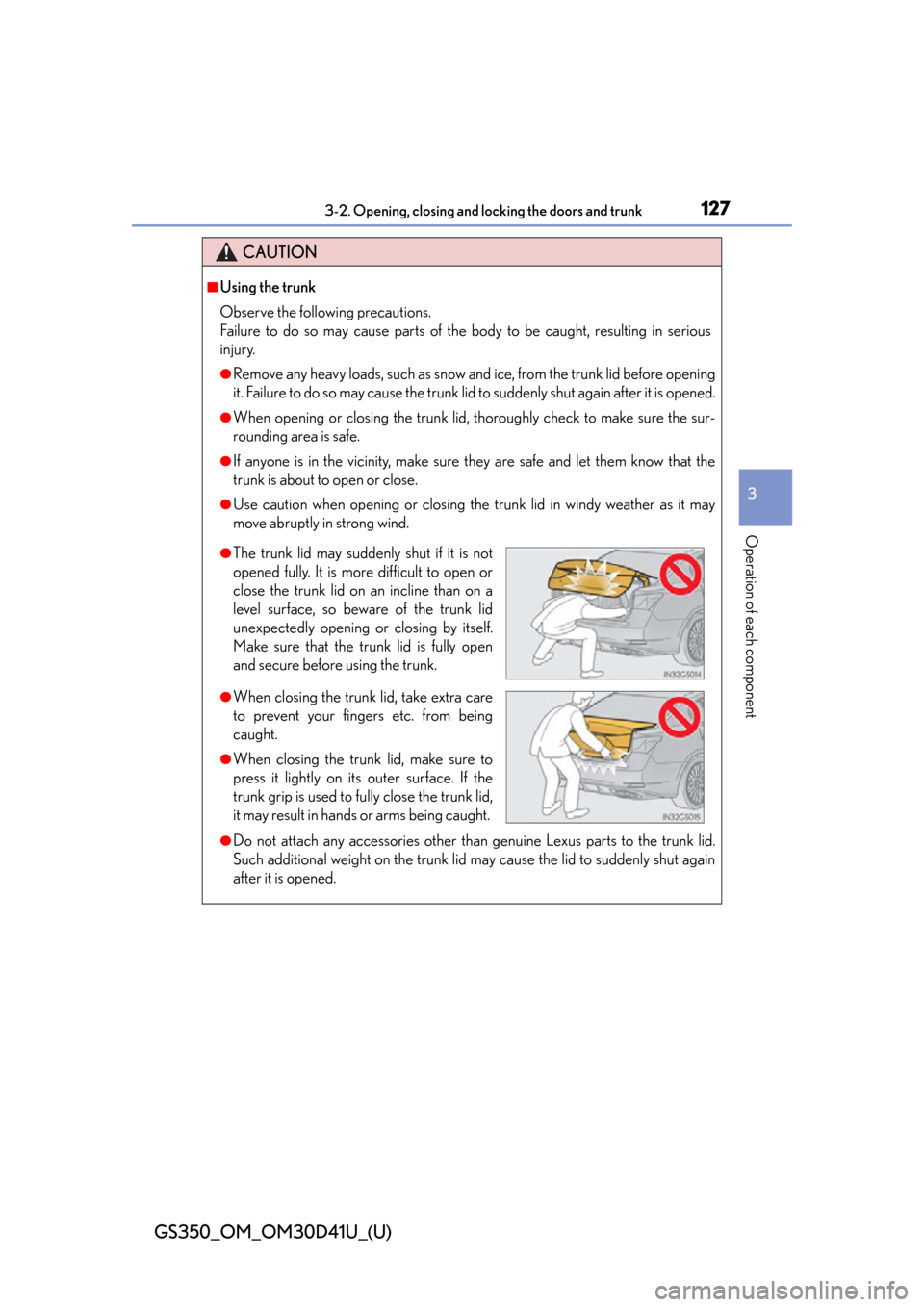
GS350_OM_OM30D41U_(U)
1273-2. Opening, closing and locking the doors and trunk
3
Operation of each component
CAUTION
■Using the trunk
Observe the following precautions.
Failure to do so may cause parts of the body to be caught, resulting in serious
injury.
●Remove any heavy loads, such as snow and ice, from the trunk lid before opening
it. Failure to do so may cause the trunk lid to suddenly shut again after it is opened.
●When opening or closing the trunk lid, thoroughly check to make sure the sur-
rounding area is safe.
●If anyone is in the vicinity, make sure they are safe and let them know that the
trunk is about to open or close.
●Use caution when opening or closing the trunk lid in windy weather as it may
move abruptly in strong wind.
●Do not attach any accessories other than genuine Lexus parts to the trunk lid.
Such additional weight on the trunk lid may cause the lid to suddenly shut again
after it is opened.
●The trunk lid may suddenly shut if it is not
opened fully. It is more difficult to open or
close the trunk lid on an incline than on a
level surface, so beware of the trunk lid
unexpectedly opening or closing by itself.
Make sure that the trunk lid is fully open
and secure before using the trunk.
●When closing the trunk lid, take extra care
to prevent your fingers etc. from being
caught.
●When closing the trunk lid, make sure to
press it lightly on it s outer surface. If the
trunk grip is used to fully close the trunk lid,
it may result in hands or arms being caught.
Page 167 of 844

167
GS350_OM_OM30D41U_(U)4-1. Before driving
4
Driving
Cargo and luggage
Cargo capacity depends on the total weight of the occupants.
(Cargo capacity) = (Total load cap acity) — (Total weight of occupants)
Steps for Determining Correct Load Limit —
(1) Locate the statement “The combine d weight of occupants and cargo
should never exceed XXX kg or XXX lbs.” on your vehicle’s placard.
(2) Determine the combined weight of the driver and passengers that will be riding in your vehicle.
(3) Subtract the combined weight of the driver and passengers from XXX kg or XXX lbs.
(4) The resulting figure equals the av ailable amount of cargo and luggage
load capacity.
For example, if the “XXX” amount equals 1400 lbs. and there will be
five 150 lb passengers in your vehi cle, the amount of available cargo
and luggage load capac ity is 650 lbs. (1400 750 (5150) = 650
lbs.)
(5) Determine the combined weight of luggage and cargo being loaded on
the vehicle. That weight may not safely exceed the available cargo and
luggage load capacity calculated in Step 4.
(6) If your vehicle will be towing a trailer, load from your trailer will be trans-
ferred to your vehicle. Consult this manual to determine how this
reduces the available cargo and luggage load capacity of your vehicle.
( P. 170)
Lexus does not recommend towing a trailer with your vehicle. Your vehicle is not
designed for trailer towing.
Take notice of the following information about storage precautions,
cargo capacity and load:
Capacity and distribution
Page 168 of 844

168
GS350_OM_OM30D41U_(U)
4-1. Before driving
Cargo capacity
Total load capacity (vehicle
capacity weight) (P. 76 8 )
When 2 people with the combined weight of A lb. (kg) are riding in your
vehicle, which has a total load capacit y (vehicle capacity weight) of B lb.
(kg), the available amount of cargo and luggage load capacity will be C lb.
(kg) as follows:
B
*2 lb. (kg) — A*1 lb. (kg) = C*3 lb. (kg)
*1: A = Weight of people
*2: B = Total load capacity
*3: C = Available cargo and luggage load
In this condition, if 3 more passengers with the combined weight of D lb. (kg) get
on, the available cargo and luggage load will be reduced E lb. (kg) as follows:
C lb. (kg) - D*4 lb. (kg) = E*5 lb. (kg)
*4: D = Additional weight of people
*5: E = Available cargo and luggage load
As shown in the example above, if the number of occupants increases, the
cargo and luggage load will be redu ced by an amount that equals the
increased weight due to the addition al occupants. In other words, if an
increase in the number of occupants causes an excess of the total load
capacity (combined weight of occu pants plus cargo and luggage load),
you must reduce the cargo and luggage on your vehicle.
Calculation formula for your vehicle
1
2
Page 169 of 844

GS350_OM_OM30D41U_(U)
1694-1. Before driving
4
Driving
CAUTION
■Things that must not be carried in the trunk
The following things may cause a fire if loaded in the trunk:
●Receptacles containing gasoline
●Aerosol cans
■Storage precautions
Observe the following precautions.
Failure to do so may prevent the pedals from being depressed properly, may block
the driver’s vision, or may result in items hitting the driver or passengers, possibly
causing an accident.
●Stow cargo and luggage in the trunk whenever possible.
●Do not place cargo or luggage in or on the following locations.
• At the feet of the driver
• On the front passenger or rear seats (when stacking items)
• On the package tray
• On the instrument panel
•On the dashboard
• In front of the Remote Touch screen
●Secure all items in the occupant compartment.
■Capacity and distribution
●Do not exceed the maximum axle weight rating or the total vehicle weight rating.
●Even if the total load of occupant’s weight and the cargo load is less than the total
load capacity, do not apply the load unevenly. Improper loading may cause dete-
rioration of steering or braking control which may cause death or serious injury.
Page 170 of 844
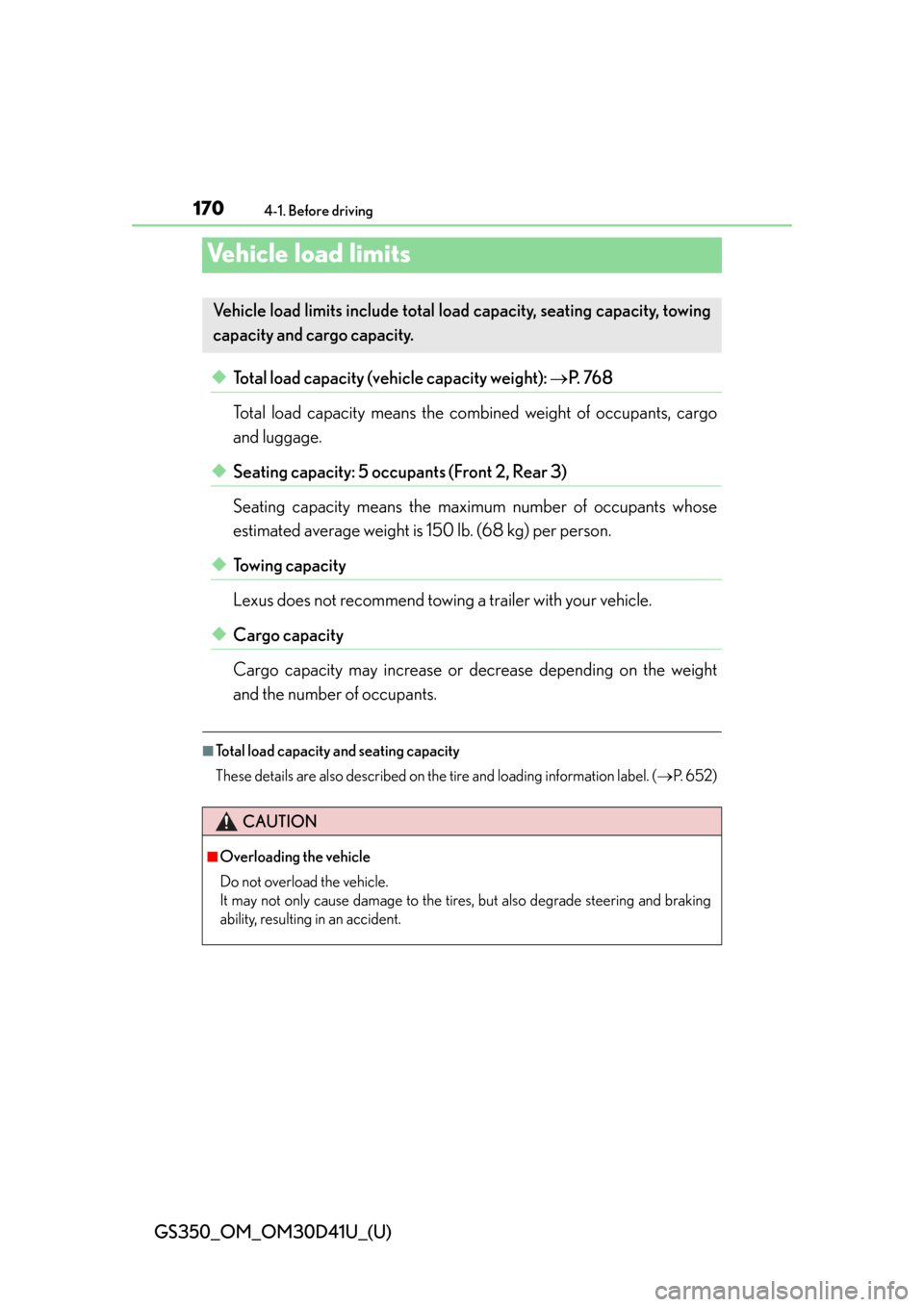
170
GS350_OM_OM30D41U_(U)
4-1. Before driving
Vehicle load limits
◆Total load capacity (vehicle capacity weight): P. 76 8
Total load capacity me ans the combined weight of occupants, cargo
and luggage.
◆Seating capacity: 5 occupants (Front 2, Rear 3)
Seating capacity means the maximum number of occupants whose
estimated average weight is 150 lb. (68 kg) per person.
◆Towing capacity
Lexus does not recommend towing a trailer with your vehicle.
◆Cargo capacity
Cargo capacity may increase or decrease depending on the weight
and the number of occupants.
■Total load capacity and seating capacity
These details are also described on the tire and loading information label. ( P. 6 5 2 )
Vehicle load limits include total load capacity, seating capacity, towing
capacity and cargo capacity.
CAUTION
■Overloading the vehicle
Do not overload the vehicle.
It may not only cause damage to the tire s, but also degrade steering and braking
ability, resulting in an accident.
Page 573 of 844
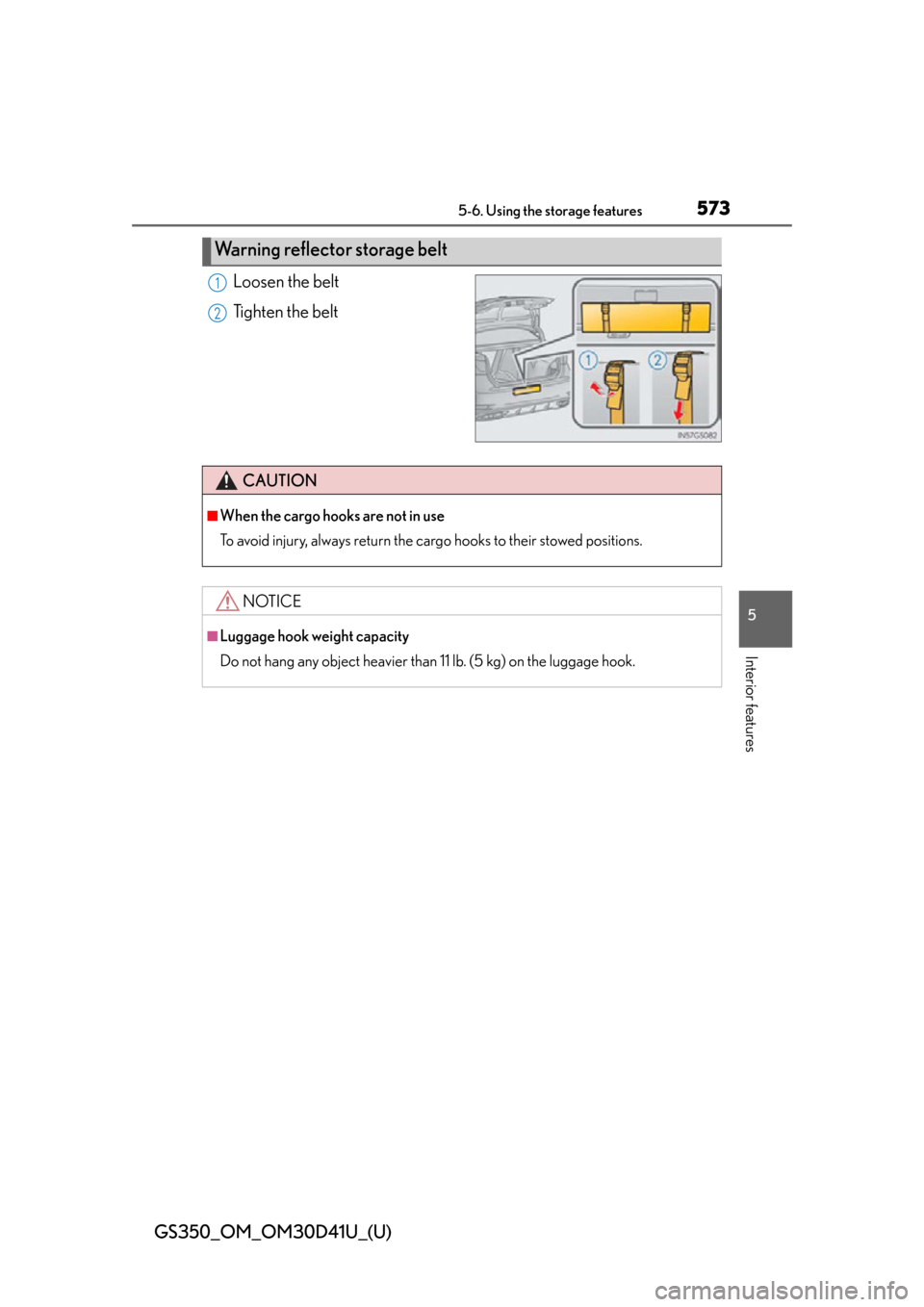
GS350_OM_OM30D41U_(U)
5735-6. Using the storage features
5
Interior features
Loosen the belt
Tighten the belt
Warning reflector storage belt
1
2
CAUTION
■When the cargo hooks are not in use
To avoid injury, always return the cargo hooks to their stowed positions.
NOTICE
■Luggage hook weight capacity
Do not hang any object heavier than 11 lb. (5 kg) on the luggage hook.
Page 592 of 844
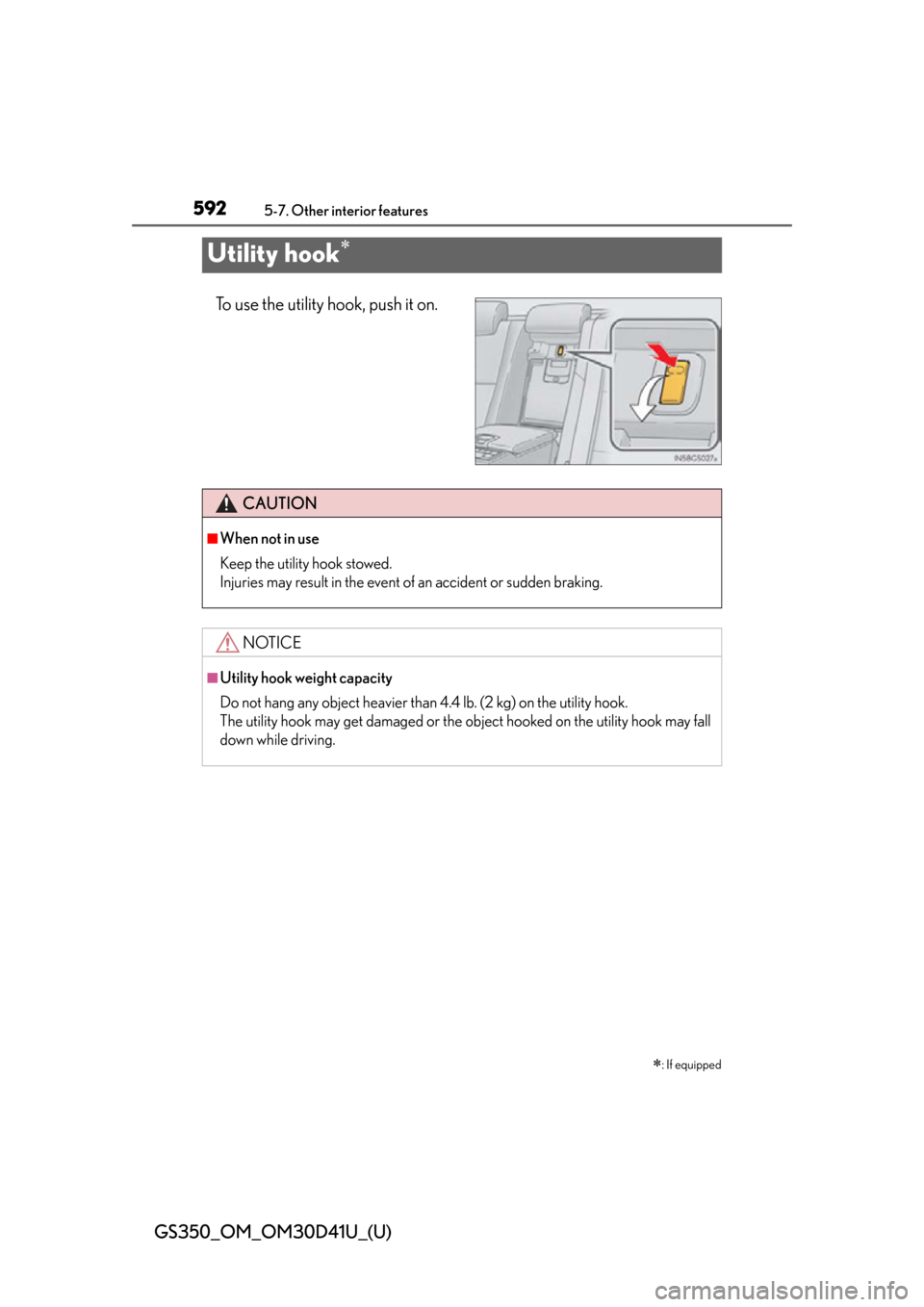
592
GS350_OM_OM30D41U_(U)
5-7. Other interior features
Utility hook
To use the utility hook, push it on.
: If equipped
CAUTION
■When not in use
Keep the utility hook stowed.
Injuries may result in the event of an accident or sudden braking.
NOTICE
■Utility hook weight capacity
Do not hang any object heavier than 4.4 lb. (2 kg) on the utility hook.
The utility hook may get damaged or the object hooked on the utility hook may fall
down while driving.
Page 644 of 844

644
GS350_OM_OM30D41U_(U)
6-3. Do-it-yourself maintenance
Your vehicle is equipped with a tire pressure warning system that uses tire
pressure warning valves and transmitters to detect low tire inflation pres-
sure before serious problems arise.
Vehicles without the tire inflation pressure display function
If the tire pressure drops below a predetermined level, the driver is
warned by a warning light. ( P. 7 0 6 )
Vehicles with the tire inflation pressure display function
●If the tire pressure drops below a predetermined level, the driver is
warned by a screen display and a warning light. ( P. 727)
●The tire pressure detected by the tire pressure warning system can be
displayed on the multi- information display. (P. 8 7 )
◆Installing tire pressure warning valves and transmitters
When replacing tires or wheels, tire pressure warning valves and trans-
mitters must also be installed.
When new tire pressure warning valves and transmitters are installed,
new ID codes must be registered in the tire pressure warning computer
and the tire pressure warning system must be initialized. Have tire pres-
sure warning valve and transmitter ID codes registered by your Lexus
dealer. ( P. 646)
◆Initializing the tire pressure warning system
■The tire pressure warning system must be initialized in the following
circumstances:
●When rotating the tires.
●When the tire inflation pressure is changed such as when changing
traveling speed or load weight.
When the tire pressure warning system is initialized, the current tire
inflation pressure is set as the benchmark pressure.
Tire pressure warning system
Page 647 of 844
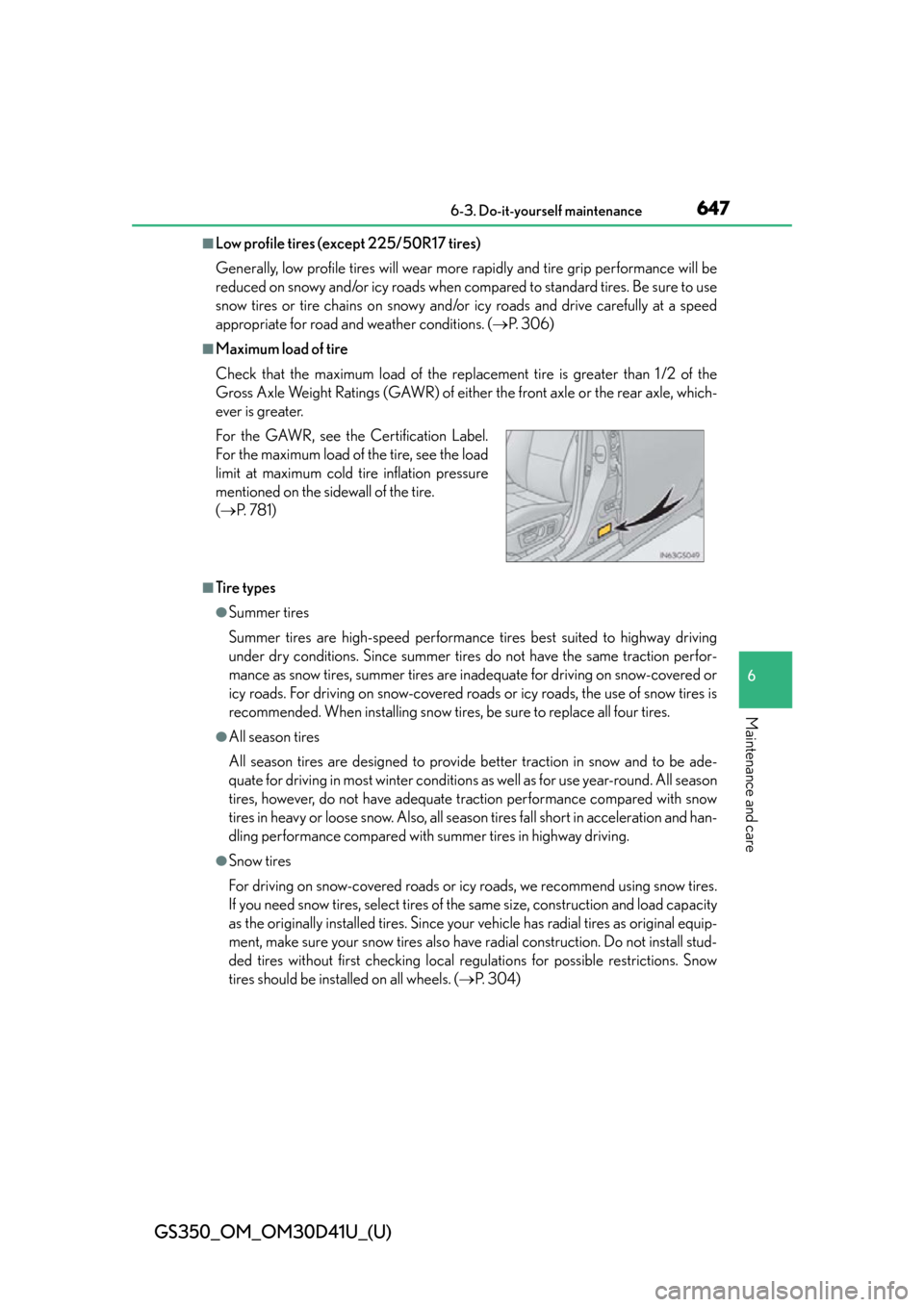
GS350_OM_OM30D41U_(U)
6476-3. Do-it-yourself maintenance
6
Maintenance and care
■Low profile tires (except 225/50R17 tires)
Generally, low profile tires will wear more rapidly and tire grip performance will be
reduced on snowy and/or icy roads when compared to standard tires. Be sure to use
snow tires or tire chains on snowy and/or icy roads and drive carefully at a speed
appropriate for road and weather conditions. ( P. 3 0 6 )
■Maximum load of tire
Check that the maximum load of the replacement tire is greater than 1 /2 of the
Gross Axle Weight Ratings (GAWR) of either the front axle or the rear axle, which-
ever is greater.
■Tire types
●Summer tires
Summer tires are high-speed performance tires best suited to highway driving
under dry conditions. Since summer tires do not have the same traction perfor-
mance as snow tires, summer tires are in adequate for driving on snow-covered or
icy roads. For driving on snow-covered road s or icy roads, the use of snow tires is
recommended. When installing snow tires, be sure to replace all four tires.
●All season tires
All season tires are designed to provide better traction in snow and to be ade-
quate for driving in most winter conditions as well as for use year-round. All season
tires, however, do not have adequate traction performance compared with snow
tires in heavy or loose snow. Also, all seas on tires fall short in acceleration and han-
dling performance compared with summer tires in highway driving.
●Snow tires
For driving on snow-covered roads or icy roads, we recommend using snow tires.
If you need snow tires, select tires of th e same size, construction and load capacity
as the originally installed tires. Since your vehicle has radial tires as original equip-
ment, make sure your snow tires also have radial construction. Do not install stud-
ded tires without first checking local regulations for possible restrictions. Snow
tires should be installed on all wheels. ( P. 3 0 4 )
For the GAWR, see the Certification Label.
For the maximum load of the tire, see the load
limit at maximum cold tire inflation pressure
mentioned on the sidewall of the tire.
(
P. 7 8 1 )